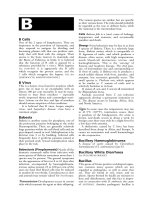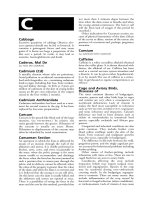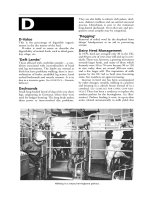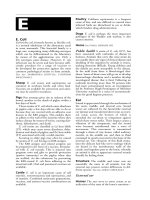Tabers Cyclopedic Medical Dictionary, 20th Edition
Bạn đang xem bản rút gọn của tài liệu. Xem và tải ngay bản đầy đủ của tài liệu tại đây (41.22 MB, 2,827 trang )
Copyright © 2005 by F. A. Davis.
44273
Davis
Tabers: Cyclopedic Medical Dict., 20/e
MasterPage
Copyright © 2005 by F. A. Davis.
short
standard
44273
Davis
Tabers: Cyclopedic Medical Dict., 20/e
MasterPage
Copyright © 2005 by F. A. Davis.
Editor
Donald Venes, M.D., M.S.J.
(For April)
Managing Editor
Arthur Biderman
Associate Managing Editor
Evelyn Adler
Assistant Editor / Database Administrator
Brigitte G. Fenton
Contributing Editor
Alison D. Enright
Copy Editors
Joseph Patwell
Deborah M. Posner
Ann-Adele Wight
Proofreaders
James Eidam
Joy Matkowski
Christopher Muldor
Pronunciation Editor
Rima Elkins McKinzey (Deceased)
short
standard
44273
Davis
Tabers: Cyclopedic Medical Dict., 20/e
MasterPage
Copyright © 2005 by F. A. Davis.
20
short
standard
44273
Davis
Tabers: Cyclopedic Medical Dict., 20/e
MasterPage
Copyright © 2005 by F. A. Davis.
Copyright 2005 by F. A. Davis Company
Copyright 1940, 1942, 1945, 1946, 1948, 1949, 1950, 1951, 1952, 1953,
1954, 1955, 1956, 1957, 1958, 1959, 1960, 1961, 1962, 1963, 1965, 1968,
1969, 1970, 1973, 1977, 1981, 1985, 1989, 1993, 1997, and 2001 by F. A.
Davis.
All rights reserved. This publication is protected by copyright. No part of
it may be reproduced, stored in a retrieval system, or transmitted in any
form or by any means, electronic, mechanical, photocopying, recording,
or otherwise, without written permission from the publisher.
PRINTED IN THE UNITED STATES OF AMERICA
Last digit indicates print number
10
9
8
7
6
5
4
3
2
1
NOTE: As new scientific information becomes available through basic
and clinical research, recommended treatments and drug therapies undergo changes. The author and publisher have done everything possible
to make Taber’s accurate, up to date, and in accord with accepted standards at the time of publication. The author, editors, and publisher are
not responsible for errors or omissions or for consequences from application of the book, and make no warranty, expressed or implied, in regard
to the contents of the book. The practices described in this book may or
may not meet professional standards of care in the reader’s community;
they may or may not apply to specific clinical situations and should not
be relied upon for their direct applicability; they may have been overtaken
by newer or more recent recommendations or scientific evidence. The
reader is always advised to research particular clinical questions further
and to check product information (package inserts) for changes and new
information regarding dose and contraindications before administering
any drug. Caution is especially urged when using new or infrequently
ordered drugs.
Library of Congress Cataloging in Publication Data
Taber’s cyclopedic medical dictionary.— Ed. 20, illustrated in full color /
editor, Donald Venes
p. ; cm.
Includes bibliographical references and index.
ISBN 0-8036-1207-9 (index)— ISBN 0-8036-1208-7 (non index)— ISBN
0-8036-1209-5 (deluxe)
1. Medicine— Dictionaries. I. Title: Cyclopedic medical dictionary.
II. Venes, Donald, 1952- III. Taber, Clarence Wilbur, 1870-1968
[DNLM: 1. Medicine— Dictionary— English. W 13 T113d 2001]
R121.T18 2001
610Ј.3— dc21
ISSN 1065-1357
00-064688
ISBN 0-8036-1208-7
ISBN 0-8036-1207-9 (indexed)
ISBN 0-8036-1209-5 (deluxe)
ISBN 0-8036-1303-2 (CD-ROM)
short
standard
44273
Davis
Tabers: Cyclopedic Medical Dict., 20/e
MasterPage
Copyright © 2005 by F. A. Davis.
DISTRIBUTORS
United States of America
LOGIN BROTHERS CANADA (EAST)
291 Traders Boulevard
Mississauga, Ontario L4Z 2E5
F. A. DAVIS COMPANY
1915 Arch St.
Philadelphia, PA 19103
Europe
Atlanta, Georgia
MEDICUS MEDIA
J. A. MAJORS COMPANY
“The Yawl”, Ferry Lane
Shepperton, Middlesex TW17 9LH
England
4004 Tradeport Blvd.
P.O. Box 82686, 30354
Lewisville, Texas
Australia, Fiji, & New
Zealand
J. A. MAJORS COMPANY
P.O. Box 819074
1401 Lakeway Drive, 75057
ELSEVIER AUSTRALIA
30-52 Smidmore Street
Marrickville NSW 2204
Australia
Los Angeles, California
J. A. MAJORS COMPANY
1220 West Walnut St.
Compton, CA 90220
Philadelphia, Pennsylvania
Mexico & Central
America
RITTENHOUSE BOOK
DISTRIBUTORS, INC.
LIBRERIA INTERNACIONAL, S. A.
DE C.V.
511 Feheley Drive
King of Prussia, PA 19406
A. Sonora 206
Col. Hipodromo
06100 Mexico, D.F.
St. Louis, Missouri
MATTHEWS BOOK COMPANY
Brazil
11559 Rock Island Court
Maryland Heights, MO 63043
ERNESTO REICHMANN,
DISTRIBUIDORA DE LIVROS
Rua Coronel Marques, 335
Tatuape
Sao Paolo— SP 03440-000
Fairfield, New Jersey
MATTHEWS BOOK COMPANY
4 Sperry Road, 07004
Canada
Guam, Saipan, & Palau
LOGIN BROTHERS CANADA (WEST)
CRW BOOKS
324 Saulteaux Crescent
Winnipeg, Manitoba R3J 3T2
4 Topaz Road, Greenheights
Taytay, Rizal, Philippines 1600
v
short
standard
44273
Davis
Tabers: Cyclopedic Medical Dict., 20/e
MasterPage
Copyright © 2005 by F. A. Davis.
India
Southeast Asia
JAYPEE BROTHERS MEDICAL
PUBLISHERS
CHOICETEXTS (ASIA) PTE. LTD
31 Kaki Bukit Road 3, #06– 07
Techlink, Singapore 417818
G/16 EMCA House
23/23 B, Ansari Rd.
Darya Ganj, New Delhi 110 002
India
Botswana
EDUCATIONAL BOOK SERVICE
P/Bag BR42
Gaborone, Botswana
Middle East
INTERNATIONAL PUBLISHERS
REPRESENTATIVES LIMITED
4 Michalakis Karaolis St.
P.O. Box 5731
Engomi, Nicosia
Cyprus
short
standard
vi
44273
Davis
Tabers: Cyclopedic Medical Dict., 20/e
MasterPage
Copyright © 2005 by F. A. Davis.
CONTENTS
INTRODUCTION TO EDITION 20 ......................................
ix
CONSULTING EDITORS AND CONSULTANTS ..................
xi
TABER’S FEATURE FINDER .............................................
xiii
FEATURES AND THEIR USE ............................................
xv
LIST OF ILLUSTRATIONS ................................................
xix
Illustration Sources .....................................................
xxviii
LIST OF TABLES .............................................................
xxxi
ABBREVIATIONS USED IN TEXT .....................................
xxxv
VOCABULARY .................................................................
1
APPENDICES ..................................................................
2373
Table of Contents ........................................................
2373
Index to Appendices .....................................................
2376
Nutrition ....................................................................
2378
Integrative Therapies: Complementary and Alternative
Medicine ....................................................................
2394
Normal Reference Laboratory Values .............................
2431
Prefixes, Suffixes, and Combining Forms ........................
2449
Latin and Greek Nomenclature .....................................
2454
Medical Abbreviations ..................................................
2463
Symbols .....................................................................
2470
Units of Measurement (Including SI Units) .....................
2471
Phobias ......................................................................
2477
Manual Alphabet .........................................................
2480
The Interpreter in Three Languages ..............................
2481
Medical Emergencies ...................................................
2496
Health Professions .......................................................
2530
vii
short
standard
44273
Davis
Tabers: Cyclopedic Medical Dict., 20/e
MasterPage
Copyright © 2005 by F. A. Davis.
Health Care Resource Organizations ..............................
2556
Professional Designations and Titles in the Health
Sciences .....................................................................
2564
Documentation System Definitions ................................
2567
Standard and Universal Precautions ..............................
2568
Recommended Immunization Schedules .........................
2579
Nursing Appendix .......................................................
2584
short
standard
viii
44273
Davis
Tabers: Cyclopedic Medical Dict., 20/e
MasterPage
Copyright © 2005 by F. A. Davis.
INTRODUCTION TO
EDITION 20
The world has changed dramatically since the last edition of Taber’s was
published.
Shortly after the terrorist attacks of September 11, 2001, spores of
anthrax were weaponized and distributed through the U.S. postal system,
and several Americans died. Bioterrorism and biological warfare, which
for years had been considered only a theoretical threat to public health,
became an actual menace. Diseases such as anthrax, smallpox, and tularemia leapt onto news headlines and into the forefront of social awareness. The potential threat of exposure to chemical warfare agents, such
as ricin, sarin, tabun, and to radioactive debris (‘dirty bombs’) suddenly
became much more real both to society at large, and to health care providers in the U.S. and around the globe.
It is safe to say that many professionals in the health and life sciences
communities have both increased their preparedness and become more
anxious about incident management. In late 2003, a newly identified,
deadly respiratory contagion spread rapidly through Asia and the Far
East. I was attending a national medical conference when this agent was
first identified; speakers at the conference worried out loud that 40 or
even 80 million might die of the emerging infection, SARS, within a year,
far eclipsing the mortality rate of the deadly influenza pandemic of 1918.
SARS did prove both contagious and deadly, but as a result of strict travel
restrictions and quarantines that were put into place, the actual number
of affected persons has, as I write this introduction, been limited to less
than 9,000, and the number of deaths, less than 800. These numbers are
significant, but the devastation could have been much worse.
Remarkably we learned in the same year that West Nile Virus had
in just a few short years spread across the entire continental U.S. by the
summer migration of infected crows and jays, and that soldiers, at war
in Afghanistan and Iraq, had been infected by tegumentary leishmaniasis
and Crimean-Congo Hemorrhagic Fever.
This new edition of Taber’s— the 20th— reflects much of what is
known about all these modern scourges, and many others. Our editorial
staff, consultants, and correspondents have combed the medical literature for new and updated information about previously unknown health
threats, developing cures, the miraculous discoveries of the Human Genome Project, and many other new approaches to health care, its delivery,
and its management. We have expanded and updated our coverage of
alternative, complementary, and integrative medicine; bioethics; drugs
and their use; evidenced-based care; informatics; nutrition; and patient
safety. This edition of Taber’s has nearly 100 new entries devoted to new
developments in radiological technology; and hundreds of columns of new
ix
short
standard
44273
Davis
Tabers: Cyclopedic Medical Dict., 20/e
MasterPage
Copyright © 2005 by F. A. Davis.
material explaining contemporary cancer care, child care, neurology, palliation, psychiatry, and women’s health care.
In all we have added 2400 new terms to this edition of Taber’s; we
have revised about 6000 others; added dozens of new tables and new
images; reviewed each and every appendix, revising most of them, some
quite extensively; and written about a hundred new patient care sections
to accompany our cyclopedic entries.
The writing, editing, and production of each edition of Taber’s is a
task that can only be performed by a skilled, dedicated, and permanent
team of professionals, working together and in parallel. I have had the
privilege and honor of working with the F.A. Davis staff and want to
mention in particular the members of the Taber’s Editorial Department
for this edition: Arthur Biderman, Evelyn Adler, Brigitte Fenton, and
Alison Enright.
This edition is the first in the last thirty years without input from
Clayton L. Thomas, M.D. Doctor Thomas served as Editor for Editions
12– 18 and as Coeditor for Edition 19. His contributions to Taber’s have
been enormous and continue to be carried forward in Edition 20.
All of us who worked on Taber’s hope that you will use it as a resource
on which to build your careers and your knowledge. We also hope it will
help you to care for yourselves and others in these uncertain times.
Donald Venes, M.D.
short
standard
x
44273
Davis
Tabers: Cyclopedic Medical Dict., 20/e
MasterPage
Copyright © 2005 by F. A. Davis.
CONSULTING EDITORS
AND CONSULTANTS
CONSULTING EDITORS
Carroll Conner Bouman, RN, PhD
Charles Christiansen, EdD, OTR, OTC, FAOTA
Judith E. Meissner, RN, BSN, MSN
Valerie C. Scanlon, PhD
Chad Starkey, PhD, ATC
CONSULTANTS
Tonia Dandry Aiken, RN, BSN, JD
Cindi Brassington, MS, CMA
Richard R. Carlton, MS, RT(R), FAERS
Marilynn E. Doenges, RN, BSN, MA, CS
Ellen Drake, BA, CMT
Robert Elling, MPA, REMT-P
Jacqueline Fawcett, PhD, FAAN
Rose S. Fife, MD
Maxine Goldman, BSHC, RN
Bruce E. Hirsch, MD, FACP
Donna Ignatavicius, MS, RN, Cm
Jeanette G. Kernicki, RN, PhD, ANP
Ruth Lipman, PhD
Mary Frances Moorhouse, RN, CRRN, CLNC
Robert F. Moran, MS, PhD, FCCM, FAIC
Betty J. Reynard, EdD, RDH
Victor S. Sierpina, MD
Susan M. Weiner, MSN, RN,C, CNS
Mary Ann Wharton, PT, MS
Robert L. Wilkins, PhD, RRT
Kathleen Young, MA, RN, C
(Material supplied by the consulting editors and consultants has been
reviewed and edited by Donald Venes, MD, MSJ, editor, with whom final
responsibility rests for the accuracy of the content.)
short
standard
xi
44273
Davis
Tabers: Cyclopedic Medical Dict., 20/e
MasterPage
Copyright © 2005 by F. A. Davis.
short
standard
44273
Davis
Tabers: Cyclopedic Medical Dict., 20/e
MasterPage
Copyright © 2005 by F. A. Davis.
short
standard
xiii
44273
Davis
Tabers: Cyclopedic Medical Dict., 20/e
MasterPage
Copyright © 2005 by F. A. Davis.
short
standard
44273
Davis
Tabers: Cyclopedic Medical Dict., 20/e
MasterPage
Copyright © 2005 by F. A. Davis.
FEATURES AND THEIR USE
This section describes the major features found in Taber’s and provides
information that may help you use the dictionary more efficiently. The
Feature Finder on page xiii is a graphic representation of many of the
features described below.
1. Vocabulary: The extensive vocabulary defined in Taber’s has been
updated to meet the ongoing needs of health care students, educators,
and clinicians, as well as interested consumers. The medical editor
and the nursing and allied health consulting editors and consultants
have researched and written new entries, revised existing entries,
and deleted obsolete ones, reflecting the many changes in health care
technology, clinical practice, and patient care. American, rather than
British, spellings are preferred.
2. Entry format: Taber’s combines two systems for the placement and
organization of entries: (a) main entries in strict alphabetical order;
and (b) a main entry– subentry format. All single-word terms (e.g.,
cell) are main entries, as are some compound, or multiple word,
terms (e.g., Alzheimer’s disease; acid-reflux disorder; nucleic
acid test). However, many compound terms, especially those in
anatomy and physiology, are placed using the main entry– subentry
format (e.g., arteries, veins, ligaments, and types of respiration). Entries having 30 or more subentries are tinted in a yellow background
for ease in finding them. This melding of two systems combines the
best features of both: compound terms that share an important common element or classification, e.g., arteries, are subentries under the
main entry (or headword). Terms that tend to be sought under the
first word, e.g., diseases, disorders, tests, and syndromes, appear as
main entries. Also names of individuals and organizations are listed
as main entries. An especially important compound term may be
listed as both a main entry and a subentry, with one of the terms
serving as a cross-reference to the other. All main entries are printed
in bold type; subentries are indented under the main entry and are
printed in bold italic type. All entries are listed and defined in the
singular whenever possible.
3. Alphabetization:
Main entries are alphabetized letter by letter, regardless of
spaces or hyphens that occur between the words; a comma marks the
end of a main entry for alphabetical purposes (e.g., skin, tenting of
precedes skin cancer). In eponyms the ’s is ignored in alphabetizing
(e.g., Albini’s nodules precedes albinism).
Subentries are listed in straight-ahead order following the same
letter-by-letter alphabetization used for main entries; a comma
marks the end of a subentry for alphabetical purposes. The headword
xv
short
standard
44273
Davis
Tabers: Cyclopedic Medical Dict., 20/e
MasterPage
Copyright © 2005 by F. A. Davis.
is often abbreviated in subentries (such as premature l. under labor
or pulmonary i. under infarction).
4. Eponyms: Included as main entries are the names of individuals
who were the first to discover, describe, or popularize a concept, a
microorganism, a disease, a syndrome, or an anatomical structure.
A brief biography appears in brackets after the pronunciation. Biographical information includes the person’s professional designation,
the country in which the person was born or worked, and the date of
birth and death if known.
5. Definitions: The text that occurs before the first period in an entry
constitutes the definition for that entry. Many entries are written in
encyclopedic style, offering a comprehensive understanding of the
disease, condition, or concept defined. See “Encyclopedic entries” for
further information.
6. Pronunciations: Most main entries are spelled phonetically. Phonetic pronunciations, which appear in parentheses after the boldface
main entry, are given as simply as possible with most long and short
vowels marked diacritically and secondary accents indicated. Diacritics are marks over or under vowels. Only two diacritics are used
in Taber’s: the macron ¯ showing the long sound of vowels, as the a
in rate, e in rebirth, i in isle, o in over, and u in unite; and the breve
˘ showing the short sound of vowels, as the a in apple, e in ever, i in
it, o in not, and u in cut. Accents are marks used to indicate stress
upon certain syllables. A single accentЈ is called a primary accent. A
double accent Љ is called a secondary accent; it indicates less stress
upon a syllable than that given by a primary accent. This difference
in stress can be seen in the word anЉes-theЈsi-a. Syllables are separated by either an accent mark or a hyphen. An unstressed vowel
sounds like the final a in anesthesia, a sound known as schwa.
7. Singular/Plural forms: When the spelling of an entry’s singular or
plural form is a nonstandard formation (e.g., villus pl. villi, or
viscera sing. viscus), the spelling of the singular or plural form appears in boldface after the pronunciation for the main entry. Nonstandard singular and plural forms appear as entries themselves at
their normal alphabetical positions.
8. Etymologies: An etymology indicates the origin and historical development of a term. For most health care terms the origin is Latin
or Greek. An etymology is given for most main entries and appears
in brackets following the pronunciation.
9. Abbreviations: Standard abbreviations for entries are included
with the definition and also are listed alphabetically throughout the
text. Additional abbreviations used for charting and prescription
writing are listed in the Appendices. A list of nonmedical abbreviations used in text appears on page xxxv.
10. Encyclopedic entries: Detailed, comprehensive information is included with entries that require additional coverage because of their
importance or complexity. Often this information is organized into
several subsections, each with its own subheading. The most frexvi
short
standard
44273
Davis
Tabers: Cyclopedic Medical Dict., 20/e
MasterPage
Copyright © 2005 by F. A. Davis.
quently used subheadings are Patient Care, Symptoms, Etiology,
Treatment, and Diagnosis.
11. Illustrations: This edition of Taber’s includes 700 illustrations, 119
of which are new to this edition. More than three fourths of the images are four-color photographs and line drawings. The images were
carefully chosen to complement the text of the entries with which
they are associated. Each illustration is cross-referenced from its associated entry. A complete list of illustrations begins on page xix.
12. Tables: This edition contains 106 color-screened tables located appropriately throughout the Vocabulary section. A complete list of tables begins on page xxxi.
13. Adjectives: The adjectival forms of many noun main entries appear
at the end of the definition of the noun form or, if the entry is long,
at the end of the first paragraph. Pronunciations for most of the adjectival forms are included. Many common adjectives appear as main
entries themselves.
14. Caution statements: This notation is used to draw particular attention to information that may affect the health and/or safety of
patients or the professionals who treat them. The information is of
more than routine interest and should be considered when delivering
health care. These statements are further emphasized by colored
rules above and below the text.
15. Synonyms: Synonyms are listed at the end of the entry or, in encyclopedic entries, at the end of the first paragraph. The abbreviation
SYN: precedes the synonymous term(s). Terms listed as synonyms
have their own entries in the Vocabulary, which generally carry a
cross-reference to the entry at which the definition appears.
16. Cross-references: Illustrations, tables, appendices, or other relevant vocabulary entries may be given as cross-references. These are
indicated by SEE: followed by the name(s) of the appropriate element(s) in italics. Cross-references to the Nursing Diagnoses Appendix are highlighted in color at the end of the entry as SEE: Nursing
Diagnoses Appendix. Entries at which an illustration appears carry
the color-highlighted SEE:illus.
17. Appendices: The Appendices contain detailed information that
could be organized or presented more easily in one section rather
than interspersed throughout the Vocabulary. This edition features
several new appendices: Health Professions; Recommended Immunization Schedules; and Latin and Greek with English Equivalent.
Among the revised appendices are Nursing Diagnoses; Standard and
Universal Precautions; Medical Abbreviations; Prefixes, Suffixes,
and Combining Forms; Conceptual Models and Theories of Nursing;
Medical Emergencies; Integrative Therapies: Complementary and
Alternative Medicine; Normal Reference and Laboratory Values;
Phobias; Nutrition; Nursing Interventions Classification System;
and Nursing Outcomes Classification System. A substantial Anatomy Appendix can be found at www.tabers20.com.
18. Nursing Diagnoses Appendix: This appendix has been updated
through the 2003– 2004 Conference of NANDA (North American
xvii
short
standard
44273
Davis
Tabers: Cyclopedic Medical Dict., 20/e
MasterPage
Copyright © 2005 by F. A. Davis.
Nursing Diagnosis Association). It is divided into several sections,
including two lists of NANDA’s nursing diagnoses organized into
Doenges and Moorhouse’s Diagnostic Divisions and Gordon’s Functional Health Patterns; an at-a-glance look at the most recent diagnoses approved by NANDA; nursing diagnoses commonly associated
with almost 300 diseases/disorders (cross-referenced from the body
of the dictionary); and a complete description of all NANDA-approved
diagnoses through the 2003– 2004 conference in alphabetical order.
Included are the diagnostic division, definition, related factors, and
defining characteristics for each nursing diagnosis. See the Quick
View of Contents on page 2656 for further explanation.
short
standard
xviii
44273
Davis
Tabers: Cyclopedic Medical Dict., 20/e
MasterPage
Copyright © 2005 by F. A. Davis.
LIST OF ILLUSTRATIONS
Illustrations are listed according to the main entry or subentry they accompany. Information in parentheses indicates the source of the illustration; a list of sources appears at the end of the list.
Abdominal quadrants
(Scanlon), 3
Abdominal regions (Scanlon), 4
Abduction/adduction of limb, 4
Abruptio placentae, 8
Intra-abdominal abscess (Harvey
Hatch, M.D.), 9
Acute abscess, 9
Abscissa, 12
Acanthocytes* (Harmening), 16
Visual accommodation, 19
Acetabulum of right hip bone
(female) (Scanlon), 20
Ribonucleic acid (Scanlon), 26
Cystic acne (Goldsmith), 30
Acne papulosa (Reeves), 30
Adenovirus (Sacher), 45
Nasopharyngeal/oropharyngeal
airway, 64
Alopecia areata (Goldsmith), 78
Alopecia capitis totalis
(Reeves), 79
Alternaria in culture (Kern), 80
Alveolus of lungs, 81
Examples of amino acids, 89
Amniocentesis, 92
Aplastic anemia
(Harmening), 106
Sickle cell anemia (effect on
erythrocytes) (Scanlon), 109
Epidural anesthesia, 112
Aortic aneurysms, 114
Angina pectoris, 116
Arterial balloon angioplasty, 121
Anthrax (Goldsmith), 130
Antibody (Scanlon), 133
Side effects of
anticoagulation, 134
Branches of aorta, 146
Reflex arc for patellar tendon
reflex, 158
Nomogram for the assessment of
body surface area (CibaGeigy), 160
Muscles of the arm (Scanlon), 164
Bones of the arm and shoulder
girdle (Scanlon), 165
Ventricular arrhythmia
(Brown), 166
Systemic arteries (Scanlon), 169
Structure of an artery
(Scanlon), 170
Brachial artery, 171
Coronary arteries, 172
Rheumatoid arthritis, 175
Arthrocentesis, 177
Ascaris lumbricoides
(Leventhal), 181
Aspergillosis of lung (Kern), 182
Aspergillus niger in culture
(Kern), 183
Audiogram, 199
Auer body (Sacher), 200
Autonomic nervous system
(Scanlon), 205
Bacillus (Bartelt), 212
How to stay on your feet without
tiring your back, 212
Bacteria (shapes and structures)
(Sacher), 215
Bacteria (Scanlon), 216
Bag-valve-mask resuscitator, 217
Balantidium coli (Leventhal), 218
Male pattern baldness
(Goldsmith), 219
Types of bandages, 222
Triangular bandages, 225
Biconcave lens/biconvex lens, 242
xix
short
standard
44273
Davis
Tabers: Cyclopedic Medical Dict., 20/e
MasterPage
Copyright © 2005 by F. A. Davis.
(Epithelial cast/fatty cast/
hyaline cast/red blood cell cast/
waxy cast/white blood cell cast)
Cataract, 356
Types of catheters, 357
Central venous catheter, 358
Catheterization of urinary
bladder, 361
Cavities of the body (Scanlon), 363
Generalized human cell and
organelles (Scanlon), 366
Burr cells (Sacher), 367
Clue cell (Sacher), 368
L.E. cell (Strasinger), 369
Target cells (Sacher), 372
Cellulitis (Kozol), 373
Cerebellum (Gilman), 379
Cerebrum (left hemisphere)
(Scanlon), 381
Typical chancre of primary
syphilis (Reeves), 385
Chancroid (Goldsmith), 386
Basal body temperature
chart, 388
Graph of respiratory movements
in Cheyne-Stokes
breathing, 396
Chilomastix mesnili
(Leventhal), 397
Chloasma gravidarum
(Reeves), 399
Cholesterol crystals
(Strasinger), 406
Action of cilia, 419
Circulation of blood through heart
and major vessels, 421
Fetal circulation (Scanlon), 422
Hepatic portal circulation
(Scanlon), 423
Portal circulation of
hypothalamus-pituitary
(Scanlon), 424
Cladosporium in culture
(Kern), 427
Clonorchis sinensis
(Leventhal), 433
Clubbing, 434
Cmax, 435
Coagulation cascade
(Harmening), 437
Coccidioides immitis spherules
(Kern), 439
Cochlea, 440
Bile ducts, 244
Bilirubin crystals
(Strasinger), 244
Punch biopsy (Goldsmith), 249
Urinary bladder (Scanlon), 255
Blastomyces dermatitidis in
culture (Kern), 257
Blood composition (Scanlon), 264
Types of blood cells (Harmening),
(Sacher), 265
ABO blood types (Scanlon), 267
Systemic blood pressure
(Scanlon), 268
Blood transfusion (Scanlon), 271
Bone tissue (Scanlon), 275
Bony structures of the thorax,
abdomen, and pelvis, 276
Hyoid bone, 277
Boutonnie`re deformity (Donald
Venes, M.D.), 281
Brain (Scanlon), 284
Vascular anatomy of brain, 285
Brainstem (Manter and
Gatz), 286
Breast (Scanlon), 287
Breast self-examination, 288
Breast cancer (AFIP), 289
Breast cancer, 290
Trachea and bronchi, 300
Buffy coat (Sacher), 303
Bullae of impetigo
(Goldsmith), 305
Burns (Scanlon), 307
Coronary artery bypass, 311
Cabot’s ring (Harmening), 313
Calcitonin (Scanlon), 316
Calcium oxalate (Strasinger),
317
Anal canal, 321
Cancer (Strasinger), 324
Candida (Sacher), 329
Candida albicans
(Harmening), 329
Candidiasis (Goldsmith), 329
Basal cell carcinoma
(Goldsmith), 339
Squamous cell carcinoma
(Goldsmith), 340
Cardiomyopathies, 342
Dental caries, 347
Casts, 352
Urinary casts (Strasinger), 353–
354
xx
short
standard
44273
Davis
Tabers: Cyclopedic Medical Dict., 20/e
MasterPage
Copyright © 2005 by F. A. Davis.
Collimator below x-ray tube
(Wallace), 448
Colon and rectum, 450
Color blindness (Scanlon), 451
Colostomy sites, 452
Spinal column, 455
Comedones (Goldsmith), 457
Condyloma (perianal warts)
(Kozol), 466
Normal and diseased coronary
arteries, 487
Organ of Corti (Scanlon), 491
Craniometric points, 499
Crown-rump (Donald Venes,
M.D.), 506
Cryptococcus neoformans
(Strasinger), 510
Cryptosporidium (Sacher), 511
Cardiac cycle (Scanlon), 520
Cyst, 522
Flow cytometry (Harmening), 530
Darier’s sign (Goldsmith), 534
Dendrites, 555
Densitometer (Wallace), 556
Dentition, 560
Depolarization (Scanlon), 562
Atopic dermatitis
(Goldsmith), 567
Contact dermatitis
(Goldsmith), 567
Stasis dermatitis
(Goldsmith), 569
Dermatofibroma (Goldsmith), 569
Dermatome, 571
Dermatomyositis
(Goldsmith), 572
Dermatographism
(Goldsmith), 572
Contraceptive diaphragm, 588
Movement of rib cage and
diaphragm during
respiration, 589
Diascopy (Goldsmith), 591
Diffusion, 600
Diphyllobothrium latum
(Leventhal), 606
Disseminated intravascular
coagulation (Harmening), 620
Multiple diverticula of the
colon, 624
Do¨hle bodies (Sacher), 625
Uniform donor card, 627
Dracunculus medinensis
(Leventhal), 633
Universal dressing, 635
Drownproofing technique, 637
Dupuytren’s contracture
(Kozol), 646
Structure of the ear
(Scanlon), 657
Ecchymosis of the leg
(Harmening), 659
Echinacea purpurea (Leonard
Perry, Ph.D.), 659
Echinococcus granulosus
(Leventhal), 659
Nummular eczema
(Goldsmith), 664
Pitting edema (Kloth), 666
Pericardial effusion (Donald
Venes, M.D.), 668
Elbow joint, 672
QRST complex of
electrocardiogram/ECG
leads, 674
Normal and abnormal
electroencephalogram wave
patterns (Merck), 677
Electrolyte concentrations in body
fluids (Scanlon), 678
Embolism, 683
Pulmonary embolism (Kozol), 684
Stages of development of human
embryo including mature
fetus, 686
Embryonic development
(Scanlon), 687
Embryoscopy, 688
Emmetropia, myopia,
hyperopia, 692
Possible sites of occurrence of
endometriosis, 704
Cuffed endotracheal tube
(Williams), 709
Barium enema (Harvey Hatch,
M.D.), 710
Entamoeba histolytica
(Leventhal), 712
Enterobius vermicularis
(Leventhal), 714
Epididymis, 723
Epiglottis, 724
Epithelial tissues (Scanlon), 730
Erysipelas (Goldsmith), 735
Erythema multiforme
(Goldsmith), 736
Normal erythrocytes
(Strasinger), 738
xxi
short
standard
44273
Davis
Tabers: Cyclopedic Medical Dict., 20/e
MasterPage
Copyright © 2005 by F. A. Davis.
Erythrocyte development †
(Harmening), 738
Eschar (Kloth), 740
Esophagus, 744
Foreign body (esophagus), 744
Isometric exercise (Kisner), 755
Range-of-motion exercises, 756
Extraocular eye muscles
(movements produced and
cranial nerve supply), 764
Extraocular eye muscles (lateral
view) (Scanlon), 765
Anatomy of the eye
(Scanlon), 766
Technique for examination of
conjunctiva, 767
Muscles of face and scalp, 771
Fasciola hepatica
(Leventhal), 779
Fasciolopsis buski
(Leventhal), 779
Right femur, 786
Ovulation, fertilization, and early
embryonic development
(Scanlon), 788
Ventricular fibrillation
(Williams), 794
Fingerprints, 802
Flatfoot (pes planus)
(Starkey), 806
Flea (Scanlon), 807
Flexion (Kisner), 808
Cerebrospinal fluid (formation,
circulation, and reabsorption)
(Scanlon), 811
Cerebrospinal fluid (specimens)
(Strasinger), 812
Pleural fluid (Strasinger), 813
Fontanels of infant skull
(Scanlon), 819
Food Guide Pyramid, 820
Bones of foot and ankle
(Scanlon), 821
Athlete’s foot (Reeves), 821
Types of fractures and
terminology, 830
Frostbite (Kozol), 836
Fungi (Scanlon), 841
Gallstones (seen endoscopically)
(Leo Eickhoff, M.D.), 847
Gallstones (plain film), 847
Gaucher’s cell (Harmening), 862
Inheritance of eye color
(Scanlon), 865
Female genital organs
(Scanlon), 868
Male genital organs
(Scanlon), 869
Genu recurvatum (Starkey), 870
Giardia duodenalis
(Leventhal), 874
Adrenal glands, 877
Endocrine system, 879
Eccrine and apocrine sweat
glands, 882
Glaucoma, 885
Glottis and vocal cords
(Scanlon), 890
Massive goiter (Williams), 896
Goniometer (Starkey), 898
Gout (Strasinger), 900
Gram stain (Sacher), 904
Granulocytopoiesis †
(Harmening), 906
Growth chart girls, 913
Growth chart boys, 914
Cerebral gyri, 919
Hair and adjacent structures of
cross-section of skin, 923
Bones of the right hand and
wrist, 926
Muscles of the head and neck
(Scanlon), 932
Arteries and veins of the head
(Scanlon), 933
Wound healing, 935
The heart (Scanlon), 939
Projection of heart and great
vessels/valves on chest
wall, 941
Conduction system of the heart
(Scanlon), 943
Complete heart block
(Brown), 944
Heart-lung machine, 946
Heimlich maneuver, 951
Helmet cell (Harmening), 952
Representative helminths
(Scanlon), 952
Hemangiomas in a neonate
(Morton), 954
Hemochromatosis
(Harmening), 961
Hemocytoblast (stem cell) and
blood cells (Scanlon), 963
Hemoglobin C disease
(Harmening), 966
xxii
short
standard
44273
Davis
Tabers: Cyclopedic Medical Dict., 20/e
MasterPage
Copyright © 2005 by F. A. Davis.
Subconjunctival hemorrhage
(Starkey), 973
Hemorrhoids, 975
Prolapsed hemorrhoids
(Kozol), 975
Henoch-Schonlein purpura
(Harmening), 977
Hiatal hernia, 984
Normal and herniated spinal
disks (Scanlon), 986
Genital herpes (Goldsmith), 988
Herpes labialis (Reeves), 989
Herpes simplex (Goldsmith), 989
Herpes zoster (Goldsmith), 990
Herpes zoster ophthalmicus
(Reeves), 991
Total hip replacement
(McKinnis), 998
Histoplasma capsulatum in
culture (Kern), 1002
Adult hookworm
(Leventhal), 1008
Anterior view of right
humerus, 1015
Hydatid cyst (Leventhal), 1018
Hydronephrosis, 1022
Hymenolepis nana
(Leventhal), 1027
Hyperplasia of a dermal mole
(Reeves), 1037
Hysterectomy, 1059
Knee immobilization
(Colyar), 1069
Cell-mediated immunity
(Scanlon), 1072
Humoral immunity
(Scanlon), 1073
Bullous impetigo (Reeves), 1080
Impetigo contagiosa in axilla
(Reeves), 1080
Endosseous dental implant, 1081
Body mass index (Shape Up
America), 1091
Inflammation (Homero Sepulveda,
Ph.D.), 1100
Intravenous infusion
technique, 1105
Inguinal canal/spermatic cord
contents, 1106
Complementary functions of
insulin and glucagon
(Scanlon), 1118
International symbol of
access, 1125
Large intestine, 1129
Small intestine (Homero
Sepulveda, Ph.D.), 1130
Irrigation of the ear canal
(Colyar), 1142
IUD (Lippincott, Williams &
Wilkins), 1150
Ixodes tick (Scanlon), 1151
Jaw, 1154
Synovial joint (Scanlon), 1158
Myoneural junction
(Scanlon), 1161
Kaposi’s sarcoma (Kozol), 1163
Karyotype of pairs of human
chromosomes of male and
female, 1165
Keloids (Kozol), 1167
Keratoacanthoma, 1169
Kerion (Goldsmith), 1172
Kidney (Scanlon), 1173
Nephron and blood vessels
(Scanlon), 1174
Formation of urine
(Scanlon), 1175
Kidney tubules (Homero
Sepulveda, Ph.D.), 1176
Anatomy of the supporting
structures of the knee, 1180
Knots, 1181
Koilonychia (Harmening), 1182
Krebs cycle, 1184
Sequence of labor and
childbirth, 1188
Labyrinths of inner ear
(Scanlon), 1193
Lacrimal apparatus
(Scanlon), 1194
Slit lamp examination (Donald
Venes, M.D.), 1200
Langer’s lines, 1202
Larynx (Scanlon), 1207
Muscles of the leg (Scanlon), 1218
Bones of the leg and foot
(Scanlon), 1219
Mucocutaneous leishmaniasis
(Leventhal), 1221
Lentigo of sun-exposed skin
(Goldsmith), 1223
Leopold’s maneuvers
(Mosby), 1223
Acute lymphocytic leukemia
(Harmening), 1228
Chronic lymphocytic leukemia
(Harmening), (Sacher), 1229
xxiii
short
standard
44273
Davis
Tabers: Cyclopedic Medical Dict., 20/e
MasterPage
Copyright © 2005 by F. A. Davis.
Lymphocytes in hairy cell
leukemia ‡ (Harmening), 1230
Oral hairy leukoplakia
(Kozol), 1233
Lichen planus (Goldsmith), 1236
Lichen simplex chronicus
(Goldsmith), 1236
Deltoid ligaments (Starkey), 1241
The limbic system of the
brain, 1246
Liver (Scanlon), 1259
Loa loa in blood (Leventhal), 1262
Louse, 1266
Lumbar puncture, 1268
Lumbar puncture
(photograph), 1269
Lungs (Scanlon), 1270
Lyme disease (Stevens), 1275
Lymph node (Scanlon), 1277
Lymphatic capillaries
(Scanlon), 1280
The lymphatic system
(Scanlon), 1281
Normal lymphocytes
(Sacher), 1282
Non-Hodgkins lymphoma
(Strasinger), 1284
Macrophage (Strasinger), 1289
Magnetic resonance imaging
(Mazziotta), 1292
Malaria-causing organisms
(Leventhal), 1295
Mammography showing breast
cancer (Kozol), 1300
Mandible— left lateral view, 1301
Normal red bone marrow
(Sacher), 1305
Mast cells (Harmening), 1308
Medic Alert symbol, 1319
Medicine wheel, 1323
Megakaryocyte (Harmening), 1326
Megaloblasts (Hillman), 1326
Meiosis, 1328
Melanoma (Goldsmith), 1329
Alveolocapillary membrane
(Scanlon), 1331
Cell membrane (Scanlon), 1332
Meninges (Scanlon), 1336
Meningitis (Sacher), 1336
Meningococcemia (Donald Venes,
M.D.), 1338
Menstrual cycle (Scanlon), 1341
Metastases (Harvey Hatch,
M.D.), 1351
Metatarsus varus, 1352
Miliaria (Goldsmith), 1365
Mitosis, 1371
Moles (Goldsmith), 1376
Molluscum contagiosum
(Goldsmith), 1377
Monocytes (Harmening), 1380
Mononucleosis (Sacher), 1381
Montgomery straps, 1384
Morton’s toe (Starkey), 1388
Mouth, tongue, and pharynx, 1390
Muscles of the trunk
(Scanlon), 1402
Muscle tissues (Scanlon), 1403
Skeletal muscle (Scanlon), 1404
Morphological forms of
muscle, 1405
Mycobacterium tuberculosis
(Sacher), 1411
Systemic mycosis (Kern), 1412
Myelofibrosis (Hillman), 1414
Multiple myeloma (Sacher), 1414
Myocardial infarction (Donald
Venes, M.D.), 1417
Nail (Scanlon), 1425
Two views of nasal cavity, 1429
Nasogastric tube (Colyar), 1430
Nebulizer (Colyar), 1434
Necator (Leventhal), 1434
Lateral aspect of the neck, 1434
Necrosis (Kloth), 1435
Neisseria gonorrhoeae
(Sacher), 1437
Acoustic nerve, 1444
Cranial nerves and their
distribution (Scanlon), 1445
Superficial branches of facial nerve
(7th cranial), 1446
Glossopharyngeal nerve, 1446
Spinal nerves (Scanlon), 1448
Neurodermatitis on neck
(Reeves), 1454
Neurofibromatosis, 1455
Acoustic neuroma (Kozol), 1457
Neuron structure (Scanlon), 1458
Neutrophils (Strasinger), 1465
Junction nevi (Goldsmith), 1466
Spider nevus (Reeves), 1467
Nocardia asteroides in culture
(Kern), 1473
Nocardiosis (Kern), 1473
Technique for control of
hemorrhage from posterior nasal
cavity, 1481
xxiv
short
standard









